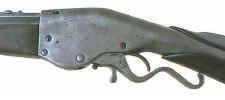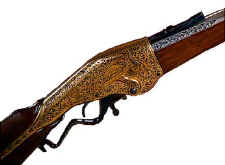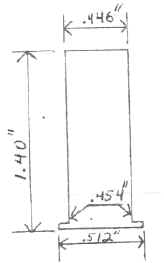![]()
The Evans Repeating Rifle
By Stephen F. Blancard
One of the most unusual yet least known rifles of the 1870’s was the Evans repeating rifle. Designed by a Maine dentist named Warren R. Evans. Together with his brother George who helped perfect the design they started the “Evans Repeating Rifle Company” of Mechanic Falls Maine in 1873.
The most unusual feature of the Evans was its magazine capacity. More than double the capacity of the Winchester. It held an astounding 34 rounds in its rotary magazine.
The basic design of the Evans repeating rifle is similar
to the Spencer. But the similarity ends here. The Evans has a rotary magazine in
the  buttstock. Cartridges are fed to the breech by cycling the cocking
lever/trigger guard. The magazine tube of
buttstock. Cartridges are fed to the breech by cycling the cocking
lever/trigger guard. The magazine tube of
the Evans is much larger than that of
the Spencer. It holds four rows of cartridges which are loaded through a
trapdoor in the buttplate. Each time the action is cycled, the magazine feeds
the next cartridge to the breech in the barber pole fashion.
The first model or what is now known as the old model was made from 1873 to 1876. This model is easily distinguished from the later models by the fact that it has only an upper buttstock. The magazine tube is exposed and runs along the bottom of the stock. Also the ejection port has no dust cover. Caliber was the .44 Evans 1” shell.
Approximately 500 old models were produced. Of these the very first (estimated serial numbers 1 to 200) have no cocking lever retaining stud on the underside of the magazine tube. Old models made after these have a stud or a locking nut to hold the lever in place. Barrel markings on the old models are as follows: “Evans Repeating Rifle/Pat. Dec 8, 1868 & Sept. 16, 1871”.
Old model Evans rifles were made in the following configurations:
-
Sporting Rifle:
Walnut stock, checkering and engraving available on special order. 26”, 28” and 30” octagon barrels. Estimated quantity made - 300.
-
Military musket:
30” round barrel, full forend retained with 2 barrel bands. Estimated quantity made - 50.
-
Carbine:
22” round barrel, short forend retained with a single barrel band. Sling swivels. Estimated quantity made - 150.
By the summer of 1873 Warren Evans had moved to Massachusetts to continue practicing dentistry. With his departure he had given up active participation in the company. However brother George had not been idle. He was in control of the company at this time and had been busy developing improvements.
By early 1876 the so-called transition model was in production. The primary difference between this and the old model is that the transition model has a two-piece buttstock and a redesigned buttplate. This improved the balance of the rifle and offered better protection of the magazine from damage or dents which could jam the action. Barrel markings on the transition model are as follows: “Evans Repeating Rifle Mechanic Falls Me./Pat, Dec. 8, 1868 & Sept. 16, 1871”.
Transition model Evans rifles were made in the following configurations:
-
Sporting Rifle:
Walnut stock, checkering and engraving available on special order. 26”, 28” and 30” octagon barrels. Estimated quantity made - 1050.
-
Military musket:
30” round barrel, full forend retained with 2 or 3 barrel bands. Estimated quantity made - 150.
-
Carbine:
22” round barrel, short forend, single barrel band, sling swivels. Estimated quantity made - 450.
-
Montreal Carbine:
A rare variation believed to have been sold in Canada by Ralph H. Kilby. A sporting goods dealer in Montreal and Evans’ Canadian agent. Estimated quantity made - less than 100.
The company received numerous testimonials from its customers. One of the more colorful ones came from Kit Carson who claimed “At twenty paces, have, with this rifle, shot the eyebrows from my wife, and every night regularly, in the presence of an audience I shot an apple from her hand, a pipe from her mouth, a penny from her fingers, or snuff a candle from her hand. I think the Evans is the safest and most complete repeating system ever devised.” Testimonials like this were great advertising and highly sought after by all the arms companies.
Requests soon reached the factory from the far west for a more powerful cartridge. George Evans listened and then went to work. The new cartridge together with numerous improvements in the design were combined to make the new model Evans repeating rifle. By the summer of 1877 the new model was perfected and put into production.
The new model is easily distinguished by its larger, more
robust receiver and sliding dust cover over the ejection port. The front  edge of
the receiver is cut straight not scalloped as in the old and transition models.
The new model was chambered for a 1 ½” long .44 caliber cartridge case.
Previous models used a 1” long case of the same caliber. The increased length
of the new cartridge necessitated a reduction in magazine capacity to only
edge of
the receiver is cut straight not scalloped as in the old and transition models.
The new model was chambered for a 1 ½” long .44 caliber cartridge case.
Previous models used a 1” long case of the same caliber. The increased length
of the new cartridge necessitated a reduction in magazine capacity to only 28
rounds. Barrel markings are the same as the transition model except with the
addition of “U.S.A.”.
28
rounds. Barrel markings are the same as the transition model except with the
addition of “U.S.A.”.
New model Evans rifles were made into the following configurations:
-
Sporting Rifle:
Walnut stock, checkering and engraving available on special order. 26”, 28” and 30” octagon barrels. Estimated quantity made - 3,000.
-
Military musket:
30” round barrel, full forend retained with 2 barrel bands, many converted to sporting rifle. Estimated quantity made - 3,000.
-
Carbine:
22” round barrel, short forend retained by a single barrel band, occasionally with a bayonet mounting stud. Estimated quantity made - 4,000 plus.
-
“Evans Sporting Rifle” marked guns:
Rifles found with this instead of the usual markings are believed to have been assembled from parts after the company went bankrupt in 1879. These were mostly 30” round barrel military muskets which had a short forend attached with a screw. This forend is quite different from the usual sporting forend.
 When Warren Evans designed his rifle he also had to
design his own cartridge. What he came up with is now known as the .44 Evans
short. This is noted in the factory catalogs as being a 1” shell. I have
checked with all the cartridge collectors at our local gun shows. But have not
been able to locate any .44 Evans shorts to verify the exact case length. The
original cartridges were loaded with 33 grains of black powder and a 220 grain
lead
When Warren Evans designed his rifle he also had to
design his own cartridge. What he came up with is now known as the .44 Evans
short. This is noted in the factory catalogs as being a 1” shell. I have
checked with all the cartridge collectors at our local gun shows. But have not
been able to locate any .44 Evans shorts to verify the exact case length. The
original cartridges were loaded with 33 grains of black powder and a 220 grain
lead bullet. This gave a velocity of about 850 fps. I made a chamber cast of my
transition carbine to try to determine the proper dimensions of the cartridge. I
found the chamber somewhat longer than 1”. These are the dimensions I
recorded.
bullet. This gave a velocity of about 850 fps. I made a chamber cast of my
transition carbine to try to determine the proper dimensions of the cartridge. I
found the chamber somewhat longer than 1”. These are the dimensions I
recorded.
Remember, these are chamber, not cartridge dimensions. I must admit that I never made any cartridges for my rifle. Considering its poor overall condition I decided it was best not to attempt to shoot it.
Harry Hoffman recommended to me that cartridges for the .44 Evans short could be made from .38-40 brass. Reduce the rim to .510”, swage the base to .450”, trim to length and fire form. These can be loaded with 25 grains of FG black powder or if you prefer (I don’t) 8 grains of Unique smokeless powder and a 180 grain cast bullet.
The more common new model Evans rifle used the 11/2” case. This was known as the “.44 New Model” cartridge. The original cartridges were loaded with 40 to 43 grains of black powder and lead bullets ranging from 275 to 300 grains. With a 280 grain bullet velocity was about 1200 fps. Both cartridges were loaded by Winchester up to the early 1920’s.
According to George Nonte’s book The Home Guide To Cartridge Conversions, this case can be made from .30-40 brass. Turn rim to .510”, swage head to .450”. Expand the neck to hold a bullet of proper size for your bore. Trim to 1.56” length and fire form. Nonte recommends a 250 grain lead bullet and 10 grains of Unique smokeless powder.
At a local gun show I picked up an Evans transition model carbine. Due to its rough condition I obtained it at a very reasonable price. Its bore was badly pitted, no finish remained and most of the internal springs were broken or missing. But nevertheless it is a fascinating example of firearms development in the 1870’s.
The construction of the Evans rifle, which basically is two halves sandwiching the barrel and internal parts is not especially strong. For its day, with black powder loads it was fine. But by modern standards it leaves something to be desired. If you have an Evans and would like to shoot it I recommend you stay with black powder or equivalent Pyrodex loads.
As usual with most .44 caliber cartridges its true diameter is not .440” My bore measured .431”. Fortunately, with all the .429” moulds available it shouldn’t be difficult to find one suitable for use in either Evans cartridge. These can be lapped out to the proper diameter as described in the May, 1984 issue of The BlackPowder Report. Of course I highly recommend that you make a chamber and a bore cast to determine the exact dimensions of your rifle.
The Evans Repeating Rifle Company went bankrupt in December of 1879. A victim of the post war arms glut, keen competition and the time. A total of almost 15,000 Evans repeating rifle were produced between 1873 and 1879. Fortunately for today’s collector a good portion of these survive. I’ve seen a number of them advertised in various antique arms publications.
The Evans repeating rifle holds the distinction of being the only firearm ever mass-produced in the state of Maine. It also had the greatest magazine capacity of any rifle mass-produced in 19th Century America. Century America.
I claim to be anything by an expert on the Evans repeating rifle. But hopefully by sharing what knowledge I’ve gathered I can shed some light on this obscure American firearm. The most detailed source of information I’ve found on the Evans rifle is a book entitled Maine Made Guns and Their Makers by Dwight B. Demeritt Jr. Available from Dixie gun Works, Union City, Tennessee.
If you have an Evans rifle and have considered shooting it, be sure to have it inspected by a competent gunsmith. I claim no responsibility for the loads listed above. Work up a safe load for your Evans and it will return many years of pleasure to you and future generations.
I welcome any comments or questions concerning the Evans repeating rifle. Good luck and good shooting.
Stephen F. Blancard
Originally published in The Blackpowder Report - 1985
